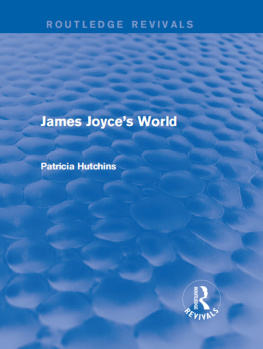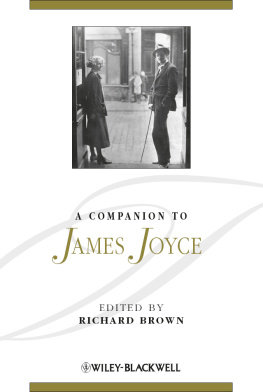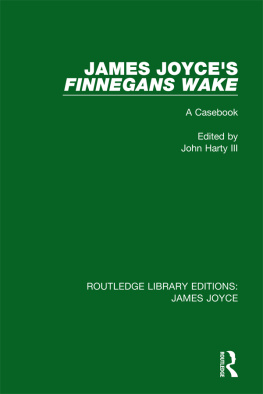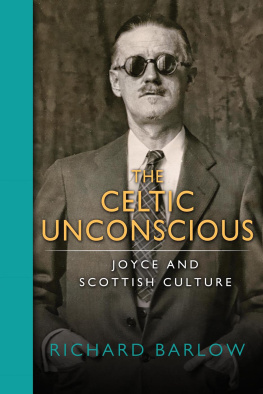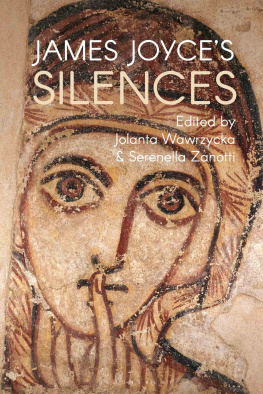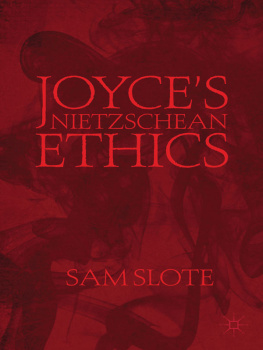
Routledge Revivals
James Joyces World
First published in 1957, this book explores what remained of Joyces background, not only in Ireland but in those cities abroad where his books were written. With the co-operation of those who knew the author, including his brother, much new material was brought together to shed new light on Joyces life, character and methods of writing. The author traces Joyce, and his writings, from his beginnings in Ireland, through Zrich, London and Paris, to his difficult final year at Vichy in 1940. Previously unpublished letters illustrate his relationships with important figures of the period like Ezra Pound, T.S. Eliot and H.G. Wells. This title will be of interest to student of literature.
James Joyces World
Patricia Hutchins

First published in 1957
by Methuen
This edition first published in 2016 by Routledge
2 Park Square, Milton Park, Abingdon, Oxon, OX14 4RN
and by Routledge
711 Third Avenue, New York, NY 10017
Routledge is an imprint of the Taylor & Francis Group, an informa business
1957 Patricia Hutchins
All rights reserved. No part of this book may be reprinted or reproduced or utilised in any form or by any electronic, mechanical, or other means, now known or hereafter invented, including photocopying and recording, or in any information storage or retrieval system, without permission in writing from the publishers.
Publishers Note
The publisher has gone to great lengths to ensure the quality of this reprint but points out that some imperfections in the original copies may be apparent.
Disclaimer
The publisher has made every effort to trace copyright holders and welcomes correspondence from those they have been unable to contact.
A Library of Congress record exists under LC control number: 57002167
ISBN 13: 978-1-138-65120-3 (hbk)
ISBN 13: 978-1-315-62488-4 (ebk)
JAMES JOYCES WORLD
by
PATRICIA HUTCHINS

First published in 1957
CATALOGUE NO. 5880/U
PRINTED AND BOUND IN GREAT BRITAIN
BY BUTLER AND TANNER LTD, FROMB AND LONDON
Loud,
heap miseries upon us
yet entwine our arts
with laughters low!

CONTENTS
ILLUSTRATIONS
PLATES
[Phyllis Thompson]
[Erica]
[Patrick Tuohy]
[National Library of Ireland]
[William Conoor]
[Lawrence Collection, National Library of Ireland]
[Photo Document]
[Lawrence Collection]
[Lawrence Collection]
[National Library of Ireland]
[National Library of Ireland]
[Patricia Hutchins]
[Walter Dryer]
[Michael Woolf]
[National Library of Ireland]
[National Library of Ireland]
[Michael Woolf]
[Patrick Tuohy]
[Michael Woolf]
[Commissioners of Public Works, Dublin]
[Michael Woolf]
[Berenice Abbott]
[Jacques Richard]
[Jacques Richard]
[C. A. Bowles]
[C. A. Bowles]
IN THE TEXT
ACKNOWLEDGEMENTS
I t would not have been possible to write this book without the cooperation of a great many people, and in acknowledging their help I must accept responsibility for any discrepancies which may remain in spite of our care. In particular I would thank Miss Harriet Shaw Weaver for unlimited patience and resourcefulness, Stuart Gilbert for advice and encouragement, and my husband, Robert Greacen, who believed it worth while from the beginning and assisted at every stage of the work.
The late Stanislaus Joyce provided a valuable commentary to the Dublin chapters which had formed the basis for my first short study, James Joyces Dublin. Giorgio Joyce showed me Zrich and Madame Eugene Jolas gave considerable assistance where Joyces life in France was concerned. L. A. G. Strong and Blanaid Salkeld also read drafts and the latter compiled useful notes on Finnegans Wake. I am also grateful to the staffs of the National Library of Ireland, the British Museum, the Lockwood Memorial Library, University of Buffalo and the Municipal Library of Vichy. In conjunction with Messrs Faber and Faber Ltd, the Trustees of the James Joyce Estate have given permission for the use of essential material and many individuals allowed other quotations. The photographers who accompanied various expeditions and others who provided portraits and snapshots are mentioned elsewhere.
I am also indebted to those who had known Joyce and his world or assisted in different ways. Among them were Samuel Beckett, Dr Richard Best, Frank Budgen, Mrs Casey, Sean OCasey, Vincent Clarke, Mrs John Drinkwater, T. S. Eliot, W. G. Fallon, R. J. Gerrard, Bernard Gheerbrant, Madame Gillet, Mrs Kathleen Griffin, Dr Richard Hayes, Felix Hackett, Patrick Hinchy, M. J. C. Hodgart, J. M. Hone, Dr and Mrs Kerrigan, Valery Larbaud, Wyndham Lewis, William K. Magee, Richard de la Mare, Niall Montgomery, Mrs Monaghan, Alida Monro, David Marcus, Madame Monceau, Phyllis Moss, Kathleen Murray, Bernard Murray, J. Middleton Murry, J. J. ONeill, Sir Harold Nicolson, George D. Painter, Ezra Pound, Madame Pontherier, Arthur Power, Joseph Prescott, W. R. Rodgers, Mrs George Roberts, Monsieur and Madame Ronchon, and the Proprietors, Htel du Commerce, St Grand-du-Puy, Mrs James Stephens, Madame Ludmila Savitzky, Walter Stucki, W. B. Stanford, Mr and Mrs Claud Sykes, Derek Stanford, William OSullivan, John J. Slocum, Owen Sheehy-Skeffington, Madame Vigneron, Carola Giedion Welcker, Mrs Marjorie Wells, Rebecca West, Dr C. G. Jung, and Mrs W. B. Yeats.
P. H.
M ost prefaces are written last, when the author has his general conclusions in mind. Unless a reader is familiar with the work and life of James Joyce, after these first few paragraphs he would do well to start in Cork. From there the book moves on to Dublin, out into Europe and back to Ireland again. It is an account of a journey which began perhaps in a house near the Vico Road in Dalkey, above the lovely little harbour of Coliemore, with its pale lion-coloured granite, and the wooded, Italian-like bays beyond. Here I met the hospitable Conan family and later became friendly with one of the daughters, Aileen, who lent me a book on Proust. This essay by Pierre Abraham, published by Les Editions Rieder, with its excellent illustrations, family portraits, photographs of Normandy, reproductions of manuscripts and notebooks, suggested that something similar should be made about Joyces Dublin backgrounda few thousand words and numerous photographs. Once started, the text grew riverwise, from talk, books and a casual exploration of the city itself.
The friendly, domestic side of Dublin, with its peace and Victorian security, remained much as Joyce had known it. Not far from the beautiful Georgian squares and gardens were country lanes, fields and barns within the boundaries of the town. The canals and little rivers with their footpaths and trees, and at low title the wide strands of the Bay, were remembered by Joyce in Pola or Trieste, beside the Zrichsee or as the light on some houses across the Seine brought back an early morning near the Pigeon House. There were many people whose eyes had once held the reality of the man himself. They could see a schoolboy running along the street to Belvedere or a student crossing St Stephens Green towards University College, a young man who entered the National Library in white canvas tennis shoes and nautical cap. In some ways it was fortunate that Joyce did not return to Dublin in the nineteen-twenties for often these impressions have not been overlaid by those of an older, sadder Joyce with for whom the book is the culminating masterpiece of naturalism, shows that in the world of
Next page
